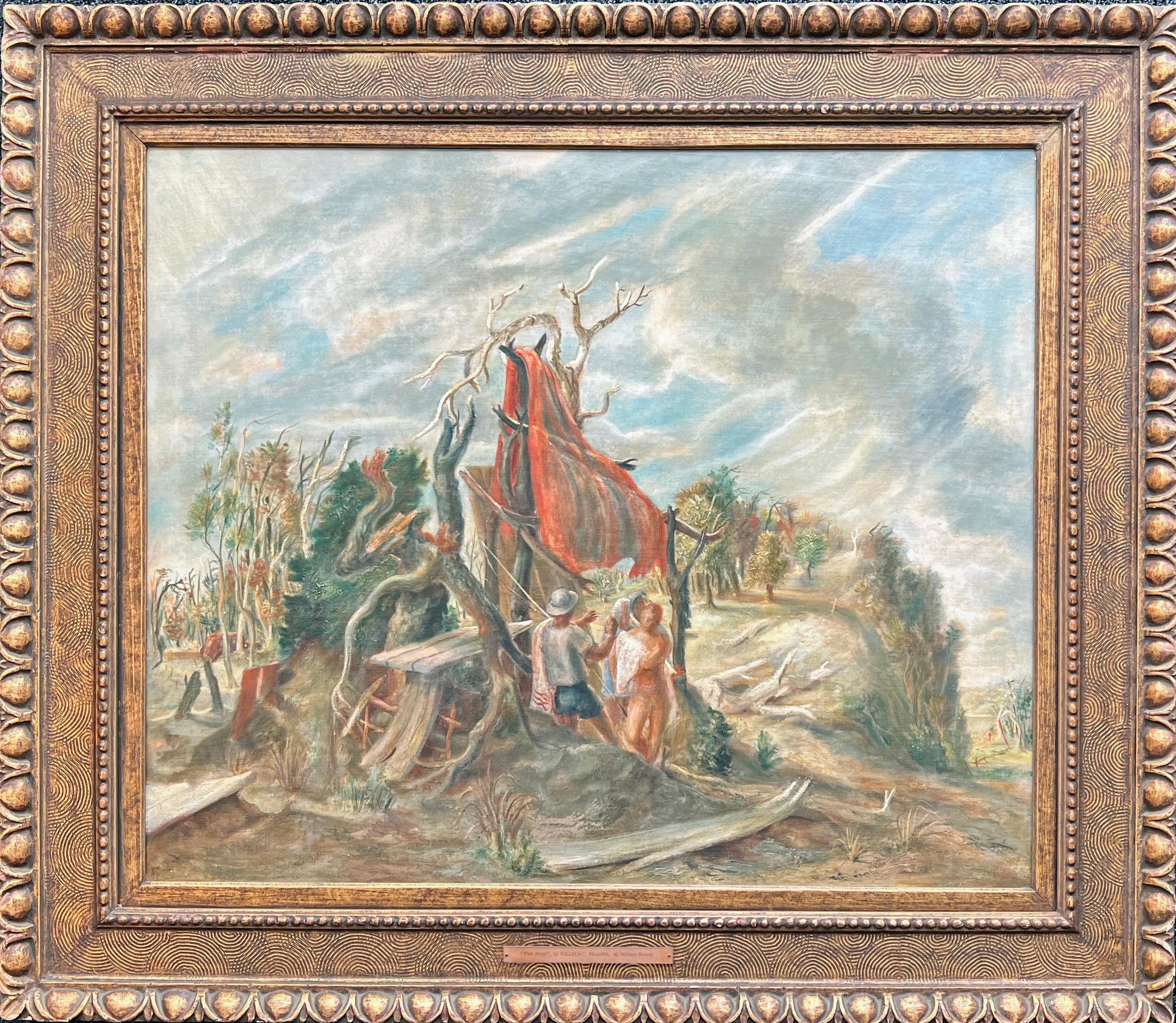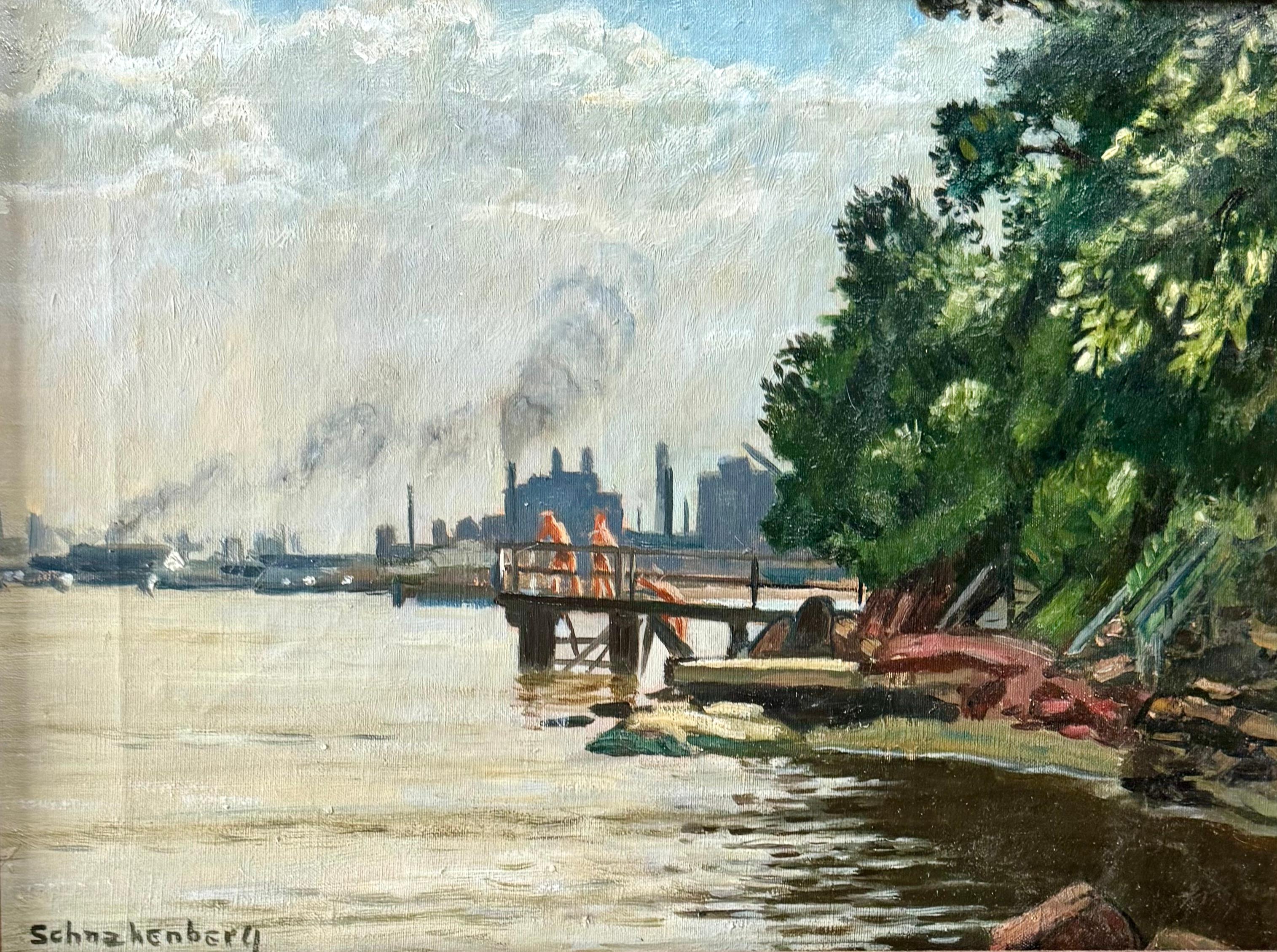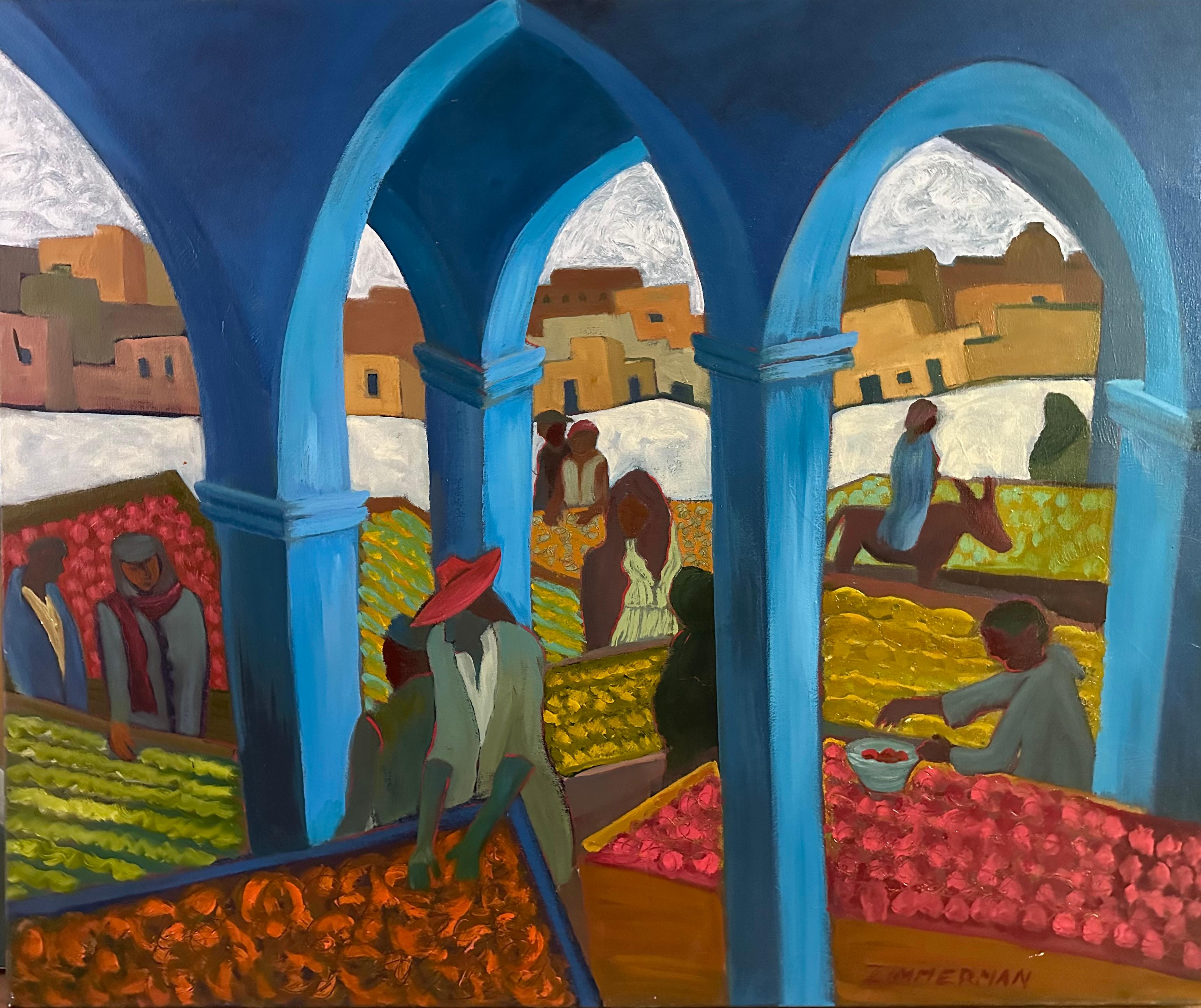Peter MillerSpring , Modernist Native American Ceremonial Scene and Cultural Commentary1940's
1940's
About the Item
- Creator:Peter Miller (1913 - 1996, American)
- Creation Year:1940's
- Dimensions:Height: 27 in (68.58 cm)Width: 32 in (81.28 cm)Depth: 2 in (5.08 cm)
- Medium:
- Movement & Style:
- Period:
- Condition:Artwork has been cleaned, varnished, re-lined, and inspected by a professional art conservator. A detailed condition report is available upon request.
- Gallery Location:Doylestown, PA
- Reference Number:1stDibs: LU1402211644862
American artist Peter Miller was born Henrietta Myers in Hanover, Pennsylvania. She began using the name Peter Miller after concluding her studies at the Pennsylvania Academy of the Fine Arts in 1934 and her marriage to fellow artist and academy student Earle Miller in 1935. She felt collectors and critics would take her paintings more seriously if she was identified as a male.
In childhood, Henrietta and her best friend Ruth picked fictitious nicknames for themselves, and Henrietta reportedly decided upon the name Peter because she liked the idea that it was derived from the Greek word for “rock” or “stone.” Drawn to being one with the natural world would prove to be an essential inspiration to her creativity throughout her life.
Miller is classified as an American modernist, a reputation she earned for having shown at the prestigious gallery and premiere showcase for Surrealist painting of Julien Levy in New York in the 1940s. Reviewers of her exhibitions noted the unmistakable influence of the artists Joan Miró, whose work she owned and whom she knew, and Arthur Carles, whom she studied with, and sources in Native American culture, which came from sharing time between her home state of Pennsylvania and New Mexico.
Miller and her husband Earle considered New Mexico their spiritual home, and in 1935 they built a ranch in Española, about 25 miles north of Santa Fe. Being neighbors of the indigenous people of the Tewa Pueblo, their crafts and religious beliefs fascinated Miller and the reliance of Native Americans upon the land and the animals permeated her work for most of her career. Their belief that all creatures could serve as intermediaries in communication with the spiritual world, inspired Miller to incorporate their symbols in her own paintings, along with signs drawn from indigenous pottery and local petroglyphs. The Millers’ intimate familiarity with the customs, rituals, and ceremonies, was assisted by their friendship with the writer Edith Warner and her friend Tilano Montoya, a Native American from the San Ildefonso Pueblo. Warner and Montoya ran a tearoom and restaurant near the Otowi Bridge by the Rio Grande, which later would become a famous meeting place for scientists associated with the Manhattan Project in nearby Los Alamos.
Miller died at her farm in Pennsylvania in 1996 at the age of 83. The Millers had no children, so upon her death, the artist left her farm and more than 250 acres of land to the Brandywine River Museum and Conservancy and the Natural Lands Trust and their ranch and land in New Mexico to the San Ildefonso Pueblo, along with a bequest of funds to the Philadelphia Museum of Art.
Find original Peter Miller paintings on 1stDibs.
- ShippingRetrieving quote...Ships From: Doylestown, PA
- Return PolicyA return for this item may be initiated within 3 days of delivery.
- Four Generations, Landscape and Figures by Female American Realist ArtistLocated in Doylestown, PA"Four Generations" is a 30 x 40 inches landscape with figures and animals, painted by female, American Realist painter, Molly Luce. The painting is signed Molly Luce in the lower lef...Category
1940s American Realist Landscape Paintings
MaterialsCanvas, Oil
- Plowing the Fields, American Impressionist Landscape with Figure and AnimalBy Henry McCarterLocated in Doylestown, PA"Plowing the Fields" is an early 20th Century American Impressionist landscape by Pennsylvania Academy graduate and teacher Henry McCarter. The 20" x 24...Category
Early 20th Century American Impressionist Landscape Paintings
MaterialsCanvas, Oil
- Harvest, Landscape and Figures by Female American Realist ArtistLocated in Doylestown, PA"Harvest" is a 30 x 40 inches landscape with farm workers by female, American Realist painter, Molly Luce. The painting is signed Molly Luce in the lower right. "Harvest" was include...Category
1930s American Realist Landscape Paintings
MaterialsCanvas, Oil
- Figures, Boats, and House - Cape May Point, NJ, Impressionist Beach Scene, 1940sBy Albert Van Nesse GreeneLocated in Doylestown, PA"Figures, Boats, and House - Cape May Point, NJ" is a Pennsylvania Beach Scene by American Impressionist painter Albert Van Nesse Greene. The ...Category
1940s American Impressionist Landscape Paintings
MaterialsOil, Canvas
- No Trespassing, Autumn Landscape and Hunters by Female American Realist ArtistLocated in Doylestown, PA"No Trespassing" is a 24 x 30 inches, New Hampshire autumn scene of two hunters walking with their dog through the woods. Painted by female, American Realist painter, Molly Luce, th...Category
1930s American Realist Landscape Paintings
MaterialsCanvas, Oil
- Fishing Boats, Gloucester MA, American Impressionist Harbor SceneBy Antonio Pietro MartinoLocated in Doylestown, PA"Fishing Boats, Gloucester, MA" is a 25" x 30" oil on canvas, New England harbor scene by Pennsylvania Impressionist painter and New Hope School member Antonio Martino. It is framed and signed "A P...Category
Early 20th Century American Impressionist Landscape Paintings
MaterialsCanvas, Oil
- Fish Story oil painting by Williams Charles PalmerLocated in Hudson, NYThis painting is illustrated in the Catalogue of the 1945 Encyclopedia Britannica Collection of Contemporary American Painting, p.84. Written and edited by Grace Pagano. "Painting ...Category
Mid-20th Century American Modern Figurative Paintings
MaterialsOil, Canvas
- City Park, Denver, Colorado, Large Semi Abstract Colorful Oil LandscapeBy Edward MarecakLocated in Denver, COLarge format oil painting on canvas of City Park in Denver, Colorado by 20th century Denver modernist, Edward Marecak. Semi-abstract park scene with various types of trees, figures, ...Category
20th Century American Modern Landscape Paintings
MaterialsOil, Canvas
- 1930 Oil Painting Sea Side Sailboats American Modernist WPA Artist Morris KantorBy Morris KantorLocated in Surfside, FLMorris Kantor, American, 1896-1974 Seaside View, 1930 Hand signed M. Kantor and dated 1930 lower right Oil on canvas 22 1/4 x 19 1/4 inches 24 1/2 x 21 (frame) Morris Kantor (Belarusian: Морыс Кантор) (1896-1974) was a Russian Empire-born American painter based in the New York City area. This is a beautiful boat scene with a river or lake probably on Long Island. Born in Minsk on April 15, 1896, Kantor was brought to the United States in 1906 at age 10, in order to join his father who had previously relocated to the states. He made his home in West Nyack, New York for much of his life, and died there in 1974. He produced a prolific and diverse body of work, much of it in the form of paintings, which is distinguished by its stylistic variety over his long career. Perhaps his most widely recognized work is the iconic painting "Baseball At Night", which depicts an early night baseball game played under artificial electric light. Although he is best known for his paintings executed in a realistic manner, over the course of his life he also spent time working in styles such as Cubism and Futurism, (influenced by the Art Deco movement) and produced a number of abstract or non-figural works. A famous cubist, Futurist, painting of his "Orchestra" brought over 500,000$ at Christie's auction house in 2018. Kantor found employment in the Garment District upon his arrival in New York City, and was not able to begin formal art studies until 1916, when he began courses at the now-defunct Independent School of Art. He studied landscape painting with Homer Boss (1882-1956). In 1928, after returning to New York City from a year in Paris, Kantor developed a style in which he combined Realism with Fantasy, often taking the streets of New York as his subject matter. He did some moody Surrealist Nude paintings and fantasy scenes. In the 1940's he turned towards figural studies. Later in his career, Kantor himself was an instructor at the Cooper Union and also at the Art Students League of New York in the 1940s, and taught many pupils who later became famous artists in their own right, such as Knox Martin, Robert Rauschenberg, Sigmund Abeles and Susan Weil...Category
1930s American Modern Landscape Paintings
MaterialsCanvas, Oil
- Boys Swimming Industrial Landscape WPA Mid 20th Century Social Realism ModernismBy Henry Ernst SchnakenbergLocated in New York, NYBoys Swimming Industrial Landscape WPA Mid 20th Century Social Realism Modernism Henry Schnakenberg (1982 - 1970) Boys Swimming Industrial Landscape 11 1/2 x 15 1/2 sight Oil on Canvas Signed lower left 14 1/2 x 18 1/2 inches, Framed Bio In many cases, American artists visited the Armory Show in New York in 1913, and returned to their studios to react to or against what they saw. However, for Henry Ernest Schnakenberg it was much more life altering. Prior to visiting this important exhibition of American and European modernist art...Category
1940s American Modern Figurative Paintings
MaterialsOil, Canvas
- The Market #2 - by Marc ZimmermanBy Marc ZimmermanLocated in Carmel, CAThe universal farmers market is bustling with action. Geometric stalls with intense color coupled with contrasting blue arches creates the dynamism in this work of art. The Market #...Category
2010s American Modern Figurative Paintings
MaterialsCanvas, Oil
- 1927 Oil Painting Eiffel Tower Paris American Modernist Wpa Artist Morris KantorBy Morris KantorLocated in Surfside, FLMorris Kantor New York (1896 - 1974) Paris from the Ile St. Louis, 1927 (view of Eiffel Tower) Oil painting on canvas Hand Signed lower left. Provenance: Hirshhorn Museum and Sculpture Garden, Smithsonian Institution ( bears label verso) Size: 20 3/4"H x 28 1/8"W (sight), 28.75 "H x 36"W (framed) Morris Kantor (Belarusian: Морыс Кантор) (1896-1974) was a Russian Empire-born American painter based in the New York City area. Born in Minsk on April 15, 1896, Kantor was brought to the United States in 1906 at age 10, in order to join his father who had previously relocated to the states. He made his home in West Nyack, New York for much of his life, and died there in 1974. He produced a prolific and diverse body of work, much of it in the form of paintings, which is distinguished by its stylistic variety over his long career. Perhaps his most widely recognized work is the iconic painting "Baseball At Night", which depicts an early night baseball game played under artificial electric light. Although he is best known for his paintings executed in a realistic manner, over the course of his life he also spent time working in styles such as Cubism and Futurism, and produced a number of abstract or non-figural works. A famous cubist, Futurist, painting of his "Orchestra" brought over 500,000$ at Christie's auction house in 2018 Kantor found employment in the Garment District upon his arrival in New York City, and was not able to begin formal art studies until 1916, when he began courses at the now-defunct Independent School of Art. He studied landscape painting with Homer Boss (1882-1956). In 1928, after returning to New York City from a year in Paris, Kantor developed a style in which he combined Realism with Fantasy, often taking the streets of New York as his subject matter. He did some moody Surrealist Nude paintings and fantasy scenes. In the 1940's he turned towards figural studies. Later in his career, Kantor himself was an instructor at the Cooper Union and also at the Art Students League of New York in the 1940s, and taught many pupils who later became famous artists in their own right, such as Knox Martin, Robert Rauschenberg, Sigmund Abeles and Susan Weil...Category
1920s American Modern Landscape Paintings
MaterialsCanvas, Oil





